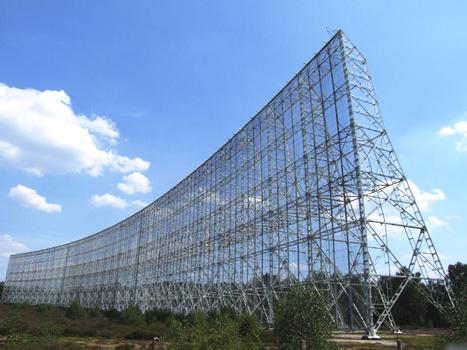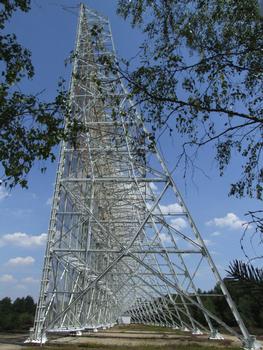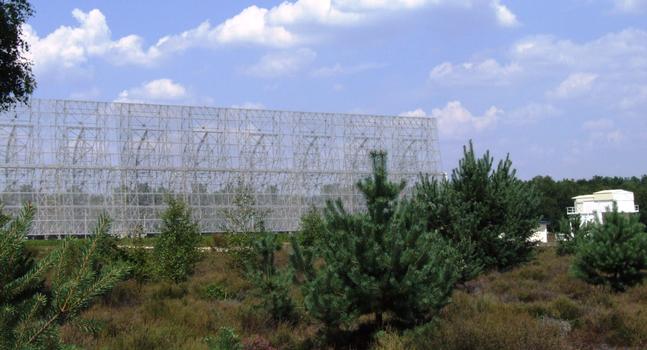General Information
| Status: | in use |
|---|
Project Type
| Function / usage: |
Radio telescope |
|---|---|
| Material: |
Steel structure |
Location
| Location: |
Nançay, Cher (18), Centre-Val de Loire, France |
|---|---|
| Coordinates: | 47° 22' 22" N 2° 11' 50.89" E |
Technical Information
There currently is no technical data available.
Excerpt from Wikipedia
The Nançay decimetric radio telescope (Le radiotélescope décimétrique de Nançay (NRT)) is part of the Nançay Radio Observatory. It is located in the small commune of Nançay, two hours' drive south of Paris, France. The radio telescope saw first light in 1965, after an inauguration by the then French president, Charles de Gaulle. It is one of the largest radio telescopes in the world.
The NRT is a transit instrument of the unusual Kraus-type design, with two mirrors. The flat, tilting primary mirror consists of ten panels, each 20 m long and 40 m (131 ft) high; it reflects radio waves towards the fixed secondary mirror 460 m to the south. The secondary mirror is shaped as a section of a sphere with a radius of 560 m: (1837 ft) it focuses the radio waves towards a mobile focal carriage 280 m to the north that contains antennas cooled by liquid helium to 20 K (−253.2 °C) and other receiving equipment. Both mirrors are covered with a metal mesh with square holes 12.5 mm on a side and a surface that is accurate to about 5 mm. The primary mirror tilts north-south to select any objects along the meridian, while the focal carriage moves east-west along a curved railroad track to follow objects across the sky. The NRT is capable of observing objects with a declination greater than −39°. Objects near the celestial equator can only be tracked for about an hour, but objects nearer the zenith can be tracked for longer. Since the mirrors of the telescope are much wider than they are high, its response function is highly elongated, being approximately 5 times wider in declination than in Right Ascension. Observations are typically undertaken at frequencies of 1,400 MHz (equivalent to a wavelength of 21 cm), 1,660 MHz (18 cm) and 3,330 MHz (9 cm).
The central fifth of the NRT was constructed in 1961 as a proof of concept. The remainder was completed in 1964, and officially opened in 1965. Scientific observations started in 1967.
The Kraus-type design, named after Dr. John D. Kraus (1910–2004), was first used at Ohio State University's Big Ear telescope.
Text imported from Wikipedia article "Nançay radio telescope" and modified on 23 July 2019 under the CC-BY-SA 3.0 license.
Participants
Relevant Web Sites
Relevant Publications
- (1962): Détermination des efforts dans certains systèmes à treillis en croix et applications aux charpentes de radiotélescope de Nancay [1ère partie]. In: Travaux, n. 338 (December 1962), pp. 861.
- (1963): Détermination des efforts dans certains systèmes à treillis en croix et applications aux charpentes de radiotélescope de Nancay [2ème partie]. In: Travaux, n. 339 (January 1963), pp. 31.
- About this
data sheet - Structure-ID
20022627 - Published on:
22/08/2006 - Last updated on:
29/07/2014











